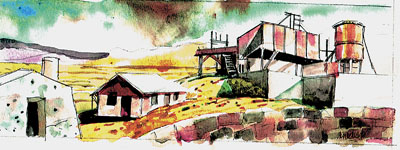Bonnie Clare ruins offer glimpse into mining past
One of scores of mining ghost towns and camps scattered across Nevada, Bonnie Clare sits within a stone's throw of the highway to Scotty's Castle. The old camp's rusted and weathered remains straggle down a slope below the stark outlines of a once-busy mill. The ruins command a view across a gray expanse known as Sarcobatus Flat marked by traces of an old railroad bed, lifeline for the camp in the bygone days when mining was king.
To reach Bonnie Clare (sometimes Claire), drive north on U.S. 95 through Beatty to Scotty's Junction. Turn onto Highway 267, the road accessing Scotty's Castle and the northern end of Death Valley National Park. The camp's ruins lie about seven miles from Scotty's Junction on the right side of the highway about 157 miles from Las Vegas. An unpaved spur takes visitors the short distance from the highway to the old town site.
When ore discoveries in 1900 led to the silver and gold boom that spawned Tonopah and Goldfield, prospectors fanned out over desert and mountains searching for other signs of minerals and precious metals. Like seasonal grasses, many mining camps sprouted quickly, lived briefly and died swiftly. A few like Bonnie Clare struggled to survive beyond the boom years. Ruins at the site mark one of Bonnie Clare's last mining ventures, the Lippincott Lead Company's smelter.
The last time Bonnie Clare had enough people to be called a camp was in 1951. For several months it served as a temporary outpost for construction crews reconstructing the highway to Scotty's Castle washed out by flash floods in Grapevine Canyon the previous year. The camp housed single men as well as families whose children attended school in Beatty. Work completed, the trailers and portable buildings moved on to other construction projects, leaving little sign of occupation at the site of the camp.
Gold mining actually began in the region in the 1880s. At Thorp's Well, four miles from the future site of Bonnie Clare, a mill processed ore from several mines to 20 years. In the early 1900s, the Bonnie Clare and Bullfrog Mining Company bought the mill. In 1904, a new mill called the Bonnie Clare was built near Thorp stage station, where overland passengers broke their journey between the Bullfrog mining district around Rhyolite to the south and Goldfield to the north. Thorp rated a post office by 1905.
Thorp and Bonnie Clare became one entity in 1906, when a town was platted after the arrival of the Bullfrog and Goldfield Railroad. The town reached its peak population of about 100 people after the Las Vegas and Tonopah Railroad arrived in 1907. It then boasted a two-story wooden hotel, stores, saloons and houses replacing an early tent community.
As long as railroading bustled, the town thrived, but when area mining activity and railroad shipping diminished, Bonnie Clare declined. Prospects brightened briefly in 1913 with a revival that brought construction of another mill, one of several small reprieves that extended Bonnie Clare's life a few more years.
In the 1920s, a new venture in Death Valley sparked interest across the region. Chicago millionaire Albert Johnson began construction of his beautiful home on Death Valley Ranch in Grapevine Canyon, a venture many believed quite eccentric. The Moorish-styled mansion soon came to be called Scotty's Castle, after Johnson's good friend Walter Scott, the legendary Death Valley Scotty who introduced Johnson and his wife to Death Valley.
Bonnie Clare became a busy siding where trainloads of construction materials off-loaded. A fleet of trucks hauled everything more than 20 dusty miles to the building site. Construction of the mansion declined during the Great Depression. Eventually, the railroad tracks were torn up for salvage. Johnson bought the ties and stockpiled them for fuel at the ranch. With mining at a standstill and railroading moribund, Bonnie Clare languished, losing its post office in 1931. Today its ruins provide visitors with glimpses of the role it played in Nevada's colorful past.
Margo Bartlett Pesek's column appears Sundays.






















